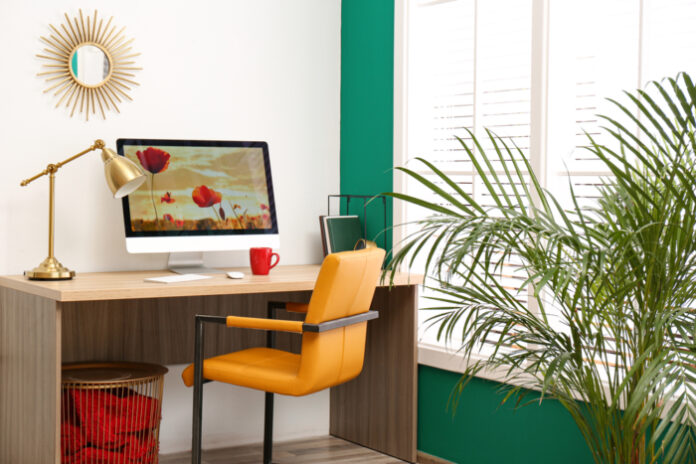People who work from home need the physical and mental space to be able to give their work the full attention it needs. However, when you work from home, it can be difficult to separate work and leisure, which can cause heightened stress and anxiety and even physical pains.
A new Work Habits Research Study commissioned by National Business Furniture of over 1,000 employed Americans finds that changing work habits over the past couple of years such as more screen time, sitting and less physical activity are taking a toll in terms of more frequent backaches, headaches and shoulder pains as well as weight gain. Now, as life takes on a new normal, it’s an opportune time to reimagine how to create home office spaces that inspire wellness and reduce physical and mental anxiety.
Here are three tips for curating a healthy home office workspace sure to help curb those Zoom meeting blues.
Act with intention
Being intentional about how your space is set up can save you stress in the long run. By tapping into your emotional health with the use of certain design and organizational choices, you may find that your energy levels are higher.
Customize with color to boost your mood
Working from home allows you to have more options with what you do with your space, like opening a window or having full command of the blinds. In the Work Habits Research study, 35 percent of working Americans said that having a window or natural light supported their health — but what if you don’t have this option, or live in an area where it’s darker?
One easy solution is to incorporate colors as a pick-me-up.
- Add a sunny, bright color palette to your walls to add energy to your workday and add pops of color to your desk with photos, desk supplies or small lamps.
- Need some natural light without the distractions of color? Consider using a pastel or white hue to attract natural light, which can also aid in energizing your workday.
Dark shades, on the other hand, can help foster concentration, according to color psychologists.
Address all of you
The most important part of your work is you. Forty percent of working Americans surveyed in the Work Habits study said that they were more depressed or anxious working from home. By addressing your wellbeing as a whole person rather than just an employee, not only can you do your best work, but lessen your feelings of anxiety and depression outside of the office:
Appeal to your senses
While color appeals to your visual senses, aim to maximize your other senses to help you be your best self to your work environment.
Many of our senses appeal to an innate desire to connect with nature and your love of living things which is called biophilia. In office spaces, this translates to finding ways to bring elements of nature indoors
Here are some tips to strengthen to add ‘green’ to your workspace and boost your emotional health:
- Bring plants into your workspace: If you don’t have a natural green thumb, you can purchase fake plants or succulents which still help to increase the sense of outdoors.
- Create a plant wall: You can also purchase wall planters to hang up your favorite flora, real or fake.
- Invest in biophilic furniture: Materials like wood can help create that cozy, safe feeling. Don’t want to invest in an entirely new desk? Try some wooden accents, like a lamp.
Enhance your day with oil diffusers
Another way to bring nature into your environment is by using an oil diffuser, which can fill your space with mood-boosting natural scents.
These devices disperse fragrant oils into the air to boost your mood and your productivity or aid in relaxation.
- Try a citrus or peppermint scent to help grow your energy levels.
- Stressed out? Lavender can cool those moods.
- Not feeling well? Stress only makes it worse. If you’re sick and can’t take time away from work, use peppermint, ginger or spearmint oils which might help you feel a little better.
Look into ergonomic options
Mental health should be a priority, but there are also some easy things you can do to invest in your physical health. Luckily, practicing ergonomics can help control pain and offer ways to prevent chronic muscle tension and back pain.
That means trading out your dining room table and chairs for ergonomic furnishings and workspace arrangements which preserve your long-term physical health. And by pushing your personal furniture to the side, you can better separate and balance your work and personal life.
Here are some tips for finding the best ergonomic options:
- Look for support: Your furniture should have appropriate back, arm and neck support with adequate cushioning and depth. If you’re unsure, it’s always recommended to try before you buy and see what has the most support.
- Adhere to adjustability: Make sure your chairs and desks are adjustable so you’ll always have a great fit.
- Choose comfort: A reclining chair with a deep, cushioned seat and armrests isn’t just cozy, but optimal for your spinal health and posture.
When in doubt, organize it out
Organizing your space can significantly decrease distractions and separate work from home. Everything from work should have a place that doesn’t interfere with your personal items.
Diminishing distractions can give you less to focus on, which in turn helps decrease your stress and anxiety levels:
Invest in organizational tools
To help find that essential separation, consider investing in organizational tools:
- Use a bulletin board or whiteboard to keep track of dates, assignments and tasks, add a personal touch with photos or organize stray notes you might need later.
- Add a paper tray to your desk to keep everything in one place and label items to better track them later.
- Use a locking file cabinet to physically separate work from your personal space and keep valuables safe in case of emergency.
- Take notes digitally to help decrease desk clutter.
Just toss it
Don’t need it? Not sure what it’s there for? Toss it, or the clutter will continue to pile up. If you’re someone that uses post-it notes or paper to organize your thoughts, make sure you throw out what you don’t need when you’re done with it.
Make Your Home Office Work for You
Your work is important, but so are you. Focus on what you can control — like your workspace — to boost both your mental health and your productivity. Even the smallest choices matter when you spend so much of your week working — you should make your home office workspace work for you.
Find a Home-Based Business to Start-Up >>> Hundreds of Business Listings.

















































